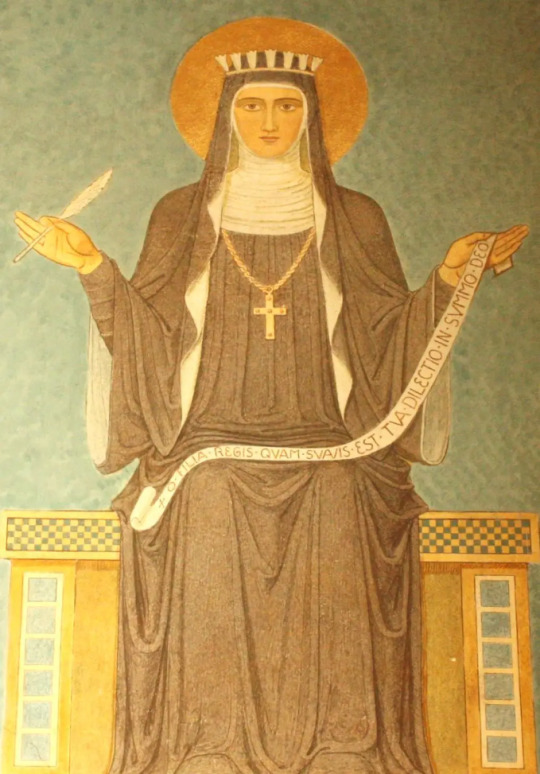#hildegarda
Text
Revisiting Hilde's design 👀

405 notes
·
View notes
Text
O céu emudecerá enquanto ressoar a sentença do juízo! E ali não haverá outras desculpas nem perguntas sobre suas obras, (...) ali as consciências dos homens, bons e maus, estarão descobertas e desnudas.
Hildegarda Von Bingen
5 notes
·
View notes
Text



Constantin d'Orsay and Hildegarda De Sardet
#Greedfall 2 on the horizon? time for replay!#my art#greedfall#digital art#digital fanart#fanart#lady de sardet#greedfall de sardet#greedfall Constantin#constantin d'orsay#de sardet#Hildegarda De Sardet#digital#oc#ilustration
28 notes
·
View notes
Text

THE DESCRIPTION OF SAINT HILDEGARD OF BINGEN
The Patron of 'Late Bloomers'
Feast Day: September 17
Abbess, artist, author, composer, mystic, pharmacist, poet, preacher, theologian—where to begin in describing this remarkable woman?
Born into a noble family, she was instructed for ten years by the holy woman Blessed Jutta. When Hildegard was 18, she became a Benedictine nun at the Monastery of Saint Disibodenberg. Ordered by her confessor to write down the visions that she had received since the age of three, Hildegard took ten years to write her Scivias (Know the Ways). Pope Eugene III read it, and in 1147, encouraged her to continue writing. Her Book of the Merits of Life and Book of Divine Works followed. She wrote over 300 letters to people who sought her advice; she also composed short works on medicine and physiology, and sought advice from contemporaries such as Saint Bernard of Clairvaux.
Hildegard’s visions caused her to see humans as 'living sparks' of God's love, coming from God as daylight comes from the sun. Sin destroyed the original harmony of creation; Christ's redeeming death and resurrection opened up new possibilities. Virtuous living reduces the estrangement from God and others that sin causes.
Like all mystics, Hildegard saw the harmony of God's creation and the place of women and men in that. This unity was not apparent to many of her contemporaries.
Hildegard was no stranger to controversy. The monks near her original foundation protested vigorously when she moved her monastery to Bingen, overlooking the Rhine River. She confronted Emperor Frederick Barbarossa for supporting at least three antipopes. Hildegard challenged the Cathars, who rejected the Catholic Church claiming to follow a more pure Christianity.
Between 1152 and 1162, Hildegard often preached in the Rhineland. Her monastery was placed under interdict because she had permitted the burial of a young man who had been excommunicated. She insisted that he had been reconciled with the Church and had received its sacraments before dying. Hildegard protested bitterly when the local bishop forbade the celebration of or reception of the Eucharist at the Bingen monastery, a sanction that was lifted only a few months before her death.
In 2012, Hildegard was canonized and named a Doctor of the Church by Pope Benedict XVI.
Source: Franciscan Media
#random stuff#catholic#catholic saints#benedictines#hildegard of bingen#hildegarda de bingen#doctor of the church
2 notes
·
View notes
Text
Kocham,
Kocham
Nie być
Kochaną
Hildegarda Hepnarova
2 notes
·
View notes
Text

Hildegarda de Bingen (1078-11799)
Santa, escritora, compositora, filosofa, científica, naturalista, medica, abadesa y mística.
8 notes
·
View notes
Text
Holland Baroque & Bastarda Trio „Minne”
Holland Baroque & Bastarda Trio „Minne”
Pentatone, 2022
Holland Baroque i Bastarda Trio. Dwa znakomite zespoły, które łączy oryginalność (i osoba Tomasza Pokrzywińskiego, będącego członkiem obu grup) oraz otwartość artystycznych poszukiwań, zaprezentowały album inspirowany dziełami Hadewijch z Brabantu.
Poza średniowieczną mistyczką, w programie płyty przywołani są inni twórcy: Giovanni Pierluigi da Palestrina, Heinrich Isaac,…

View On WordPress
#Bastarda#Giovanni Pierluigi da Palestrina#Hadewijch z Brabantu#Heinrich Isaac#Hildegarda z Bingen#Holland Baroque#Judith Steenbrink#Melchior Franck#Michał Górczyński#Paweł Szamburski#Tomasz Pokrzywiński
0 notes
Text

Battlepriest/ Zealot Hildegarda Burn, Agent of the Golden Throne
34 notes
·
View notes
Text
happy birthday Bloodborne!! some of my fan arts for today :)
prints ✦ patreon






#bloodborne#lady maria of the astral clocktower#lady maria#kos#the moon presence#gherman#hildegarda#my art
1K notes
·
View notes
Note
Como se llama la canción que va tururururutururu
(Sale una chichona)
Con Hildegarda de Bingen no te metas
4 notes
·
View notes
Note
Ask game, y e s.
Homer (throw in the Divine Comedy too, because it's you)
Medea
Dioegenes
Turnus
Have fun!
Homer: Iliad, Odyssey, or Aeneid? (+ Divine Comedy because I'm not gonna say no to that).
DAMN you love to bring pain. It's gonna be hard. Of course I always say the Odyssey 100% to anything, but the Divine Comedy is a big guilty pleasure so nksfndfjsgl and the Iliad and the Aeneid are really cool too i'm just... an Odysseus fanatic [dramatic crying in the background].
Medea: Most underappreciated ancient figure?
If we're going for historical figures, LET ME TELL YOU ABOUT HILDEGARDA VON BINGEN, I know she's from Medieval Times, not exactly Ancient BUT hear me out. She was a nun chilling, writing her thoughts, living life, she literally started GOD KNOWS WHAT kind of fight in order to keep a corpse buried down in her convent, the amount of shenanigans she went through by keeping it are very funny.
Diogenes: Favourite random/weird/amazing fact or story that you use to show people that classics is fun?
I always go back to Virgil and his pet fly. The fact that he kept his house due to claiming it to be "sacred ground" because his pet fly was buried there is so funny. He literally held a funeral in order to prove it. I always bring up that fact, my friends are pretty tired of it NDKSNDK
Turnus: Which ancient death haunts you?
Oof, a couple of them. The first one I always say is Hector's death, there's no competition there. But when we go to real figures... It's Virgil. Just. The guy died wishing that the Aeneid got burned down, he died of sickness too. It's just, a little bit hurting. He spent so long writing the Aeneid to then. just die. thinking he did a failure.
Thanks a bunch for the asks, Quill !!!
#unironically. that's why Virgil's goodbye in the Divine Comedy made me cry#i'm a grown adult i swear it#tagamemnon#ask game#answered#quill-is-brainstorming
17 notes
·
View notes
Text
instagram
Logo vem a Primavera.
A primavera é a estação em que as plantas possuem mais viriditas, ensina Santa Hildegarda. É a estação perfeita para colher ervas aromáticas e hortaliças. No entanto, um pouco antes, no fim do outono, se poda algumas plantas, como a lavanda. Se faz isso, para que possuam mais força e novas folhas nasçam na Primavera, justamente por ser a estação em que estão mais fortes.
Esse período de poda, coincide, no Brasil, com o mês de Setembro, dedicado ao aperfeiçoamento da Virtude da Mortificação. Afinal, o que é essa virtude senão uma poda orquestrada, programada, anual, para dar melhores frutos de virtude nos outros meses?
No entanto, se você já precisou podar uma planta, sem que ela estivesse com alguma praga visível, sabe que é uma tarefa difícil. Algumas plantas precisam ser podadas em 2/3! Parece que nunca mais vão crescer. Mas é impressionante, logo no dia seguinte começam a dar brotos... Aquele tamanho todo, todos aqueles galhos e folhas, ramificações, não estavam fazendo bem à planta. Ela estava grande, mas não dava folhas novas, estava fadigada.
Poda anual é uma regra necessária para algumas plantas. Talvez as almas também sejam assim... é preciso desapegar, mas quando se trata de coisas profundas, ramificações incrustradas no fundo do coração, que impedem a vida de fluir... bem, quando isso acontece, é preciso podar. Mortificar.
Podar as coisas excessivas, tirar os olhos das coisas inúteis, diminuir um tanto para ficar mais forte nos próximos meses, isso é mortificar.
Sim, dói. Uma dor espiritual. Cortar coisas profundas gera aquele sentimento de certa agonia interior mas, como quando se poda lavanda, gera um perfume de suave odor que se levanta até o Céu.
Há quem possa apontar que a vida já é puxada, não precisamos, portanto, dessa virtude. Mas, embora eu acredite que não estejamos na altura de pedir sofrimentos, talvez seja adequado se abrir à oportunidade das podas anuais que nos fazem resolver tantas coisas interiores, coisas estas que fazem a vida patinar, causam certos desequilíbrios interiores ou disputas nas sombras do coração. Vale à pena pedir luz para ver essas linhas, cordas ou grilhões interiores que nos prendem. Só ao vê-los teremos já uma dose considerável de mortificação. Depois a graça de se ver livre deles.
Continua em: https://www.salusincaritate.com/2023/09/a-virtude-da-mortificacao-mes-de-setembro.html?m=1
2 notes
·
View notes
Text
AS VISÕES DE HILDEGARDA DE BINGEN
Até aos quarenta anos
insistiram em dar-me óculos para ver ao longe.
Depois dos quarenta anos,
insistiram em dar-me óculos para ver ao perto.
Vi mal metade da minha vida.
A outra metade? Também.
A paisagens enevoadas
sucederam-se ensonadas letras:
chovia entre mim e a realidade,
como se fosse Inverno sempre
e fosse o Norte sempre mais além.
Agora fecho os olhos, abatida,
e pergunto-me se saberei passar
do olhar à visão.
(Gemma Gorga)
6 notes
·
View notes
Photo

"Um ser humano é um vaso que Deus construiu para si mesmo e cheio de sua inspiração para que suas obras sejam aperfeiçoadas nele." . . Santa Hildegarda, rogai por nós! @fepizz te dedico ✌🏽 . . #santahildegarda #hildegardvonbingen #colagemdigital #santododia #frasesdesantos #igrejacatolica #pax https://www.instagram.com/p/CinFjyGLDuQ/?igshid=NGJjMDIxMWI=
6 notes
·
View notes




